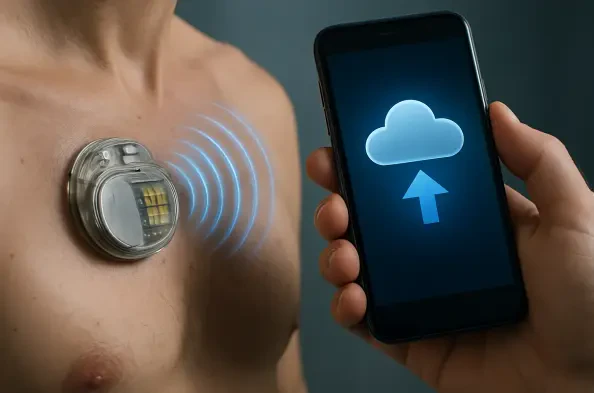In the rapidly advancing realm of medical technology, a startling innovation is capturing attention with the potential to transform how implantable devices interact with external systems, offering a new frontier in healthcare solutions. Picture a scenario where light, rather than conventional radio waves, serves as the conduit for data exchange between medical implants and the outside world, delivering faster, safer, and more secure connections. This concept, rooted in the emerging field of optical wireless communication (OWC), is not a distant dream but a tangible breakthrough being explored by researchers today. With the ability to address critical limitations of current methods, this technology could redefine the functionality of devices like pacemakers, glucose monitors, and neural implants. The promise lies in harnessing visible and near-infrared light to transmit data through human skin, offering a pathway to enhanced patient care. This article delves into the mechanics, benefits, and challenges of this pioneering approach, shedding light on its potential to reshape healthcare delivery.
Breaking Away from Radio Frequency Constraints
The reliance on radio frequency (RF) communication for implantable medical devices has long been a cornerstone of biomedical engineering, yet it comes with significant shortcomings that hinder progress. RF signals often degrade when passing through biological tissues, resulting in weakened data transmission and restricted bandwidth that can compromise the performance of critical health-monitoring tools. Beyond signal loss, the risk of electromagnetic interference with other electronic devices poses a persistent threat, potentially disrupting the operation of life-sustaining implants. Moreover, the broader radiation of RF waves raises concerns about data security, as these signals can be intercepted, endangering patient privacy. These multifaceted issues underscore the urgent need for an alternative communication method that can ensure reliability and safety in medical applications, setting the stage for innovations like optical wireless communication to step into the spotlight.
Optical wireless communication offers a compelling solution by sidestepping the inherent flaws of RF systems through the use of light as a data transfer medium. By employing specific wavelengths in the visible and near-infrared spectrum, OWC achieves better penetration through skin with minimal signal degradation, ensuring more consistent performance. Unlike RF waves, light signals do not generate electromagnetic interference, eliminating the risk of disruption from nearby electronics. Additionally, the localized nature of light transmission drastically reduces the chance of unauthorized access to sensitive medical information, bolstering data security. This shift to light-based technology could mark a turning point for implantable devices, providing a robust framework for high-speed communication that prioritizes both efficiency and patient protection, while addressing some of the most pressing challenges faced by current systems.
Unveiling the Mechanics of Light-Based Technology
At the heart of optical wireless communication lies a sophisticated system designed to facilitate seamless data transfer between implantable devices and external interfaces using light. This technology employs miniaturized optical transceivers embedded within implants, working in conjunction with external light emitters and detectors to send and receive information through layers of human skin. Research has demonstrated the ability to achieve data rates of several megabits per second, even across millimeters of tissue, by leveraging carefully selected wavelengths that optimize penetration. Techniques such as pulse-position modulation are utilized to enhance data throughput while maintaining low power consumption, a critical consideration for devices intended to operate within the body for extended periods without frequent battery replacements.
Safety and compatibility with the human body remain paramount in the development of this technology, prompting meticulous attention to the materials and operational parameters involved. The optical components are crafted from biocompatible substances to prevent adverse reactions, ensuring long-term viability within the body. Extensive studies on light propagation through skin have mapped out factors like absorption and scattering, allowing researchers to pinpoint wavelengths and power levels that are both effective for communication and compliant with biomedical safety standards. This rigorous approach not only validates the practicality of OWC for medical implants but also highlights the potential for scalability, as ongoing refinements aim to make these systems even more efficient and accessible for widespread clinical use.
Transforming Patient Care with New Possibilities
The implications of light-based data transfer for patients reliant on implantable medical devices are nothing short of revolutionary, promising a leap forward in personalized healthcare. Consider a scenario where a pacemaker continuously relays detailed cardiac data to a physician in real time, enabling immediate interventions without the delays often associated with traditional systems. Similarly, continuous glucose monitors could transmit instantaneous alerts about blood sugar fluctuations to a patient’s smartphone, facilitating rapid responses to prevent dangerous episodes. The high-speed, low-latency nature of OWC supports dynamic monitoring and treatment adjustments, aligning perfectly with the growing emphasis on tailored medical approaches that cater to individual physiological needs.
Beyond managing chronic conditions, this technology holds immense potential for advanced applications such as neural implants used in brain-computer interfaces. These devices could transmit intricate electrophysiological data to support innovations like prosthetic limb control or real-time epilepsy monitoring, enhancing both functionality and safety. By minimizing interference and ensuring dependable data fidelity, optical wireless communication stands to elevate the standard of care for millions globally. The ability to maintain secure, uninterrupted connections between implants and external systems could fundamentally improve quality of life, offering patients greater autonomy and confidence in managing their health with cutting-edge support.
Navigating the Roadblocks to Adoption
While the prospects of optical wireless communication in medical implants are exciting, several challenges must be addressed to bridge the gap between experimental success and practical implementation. One significant hurdle is maintaining precise optical alignment between the implanted transceiver and the external light source, as even slight patient movement can disrupt connectivity. This issue complicates the reliability of data transfer in real-world scenarios where individuals are active and mobile. Researchers are exploring solutions such as adaptive optics to dynamically adjust for movement, but achieving consistent performance across diverse conditions remains a complex task that demands further innovation and testing.
Another critical area of focus is the miniaturization of optical components to reduce the invasiveness of implants, alongside optimizing their placement within the body for maximum efficacy. Smaller devices are essential for patient comfort and surgical feasibility, yet shrinking technology without sacrificing performance is a delicate balance. Additionally, integrating external light emitters into wearable formats that are both user-friendly and effective poses its own set of design challenges. Current efforts are directed toward overcoming these obstacles through interdisciplinary collaboration, aiming to refine OWC systems into viable, mainstream solutions that can seamlessly integrate into clinical practice over the coming years.
Charting the Future of Biomedical Connectivity
Reflecting on the journey of optical wireless communication, it’s evident that this technology has carved a significant milestone in addressing the persistent limitations of radio frequency systems for medical implants. Its ability to deliver high-speed, secure data transfer with minimal power usage redefines expectations for device performance, setting a new benchmark for safety and efficiency. The rigorous validation of biocompatible materials and safe light wavelengths underscores a commitment to patient well-being, while early demonstrations of real-time data capabilities hint at transformative clinical outcomes. These achievements lay a solid foundation for reimagining how healthcare technology could evolve.
Looking ahead, the next steps involve accelerating research to solve lingering issues like alignment and component size, with an eye toward practical deployment in hospitals and clinics. Collaborative efforts across engineering, medicine, and material science will be crucial in crafting solutions that are both innovative and accessible. As adaptive technologies and wearable integrations advance, the vision of light-driven implants could become a cornerstone of modern healthcare, offering a future where seamless connectivity enhances patient outcomes and drives progress in medical science on a global scale.






